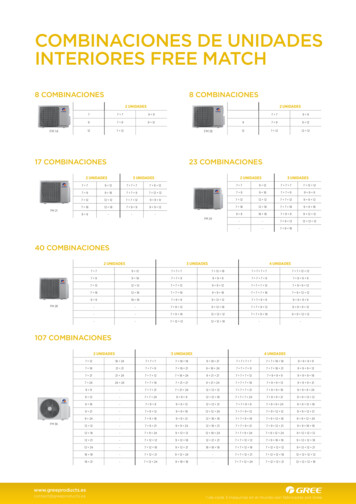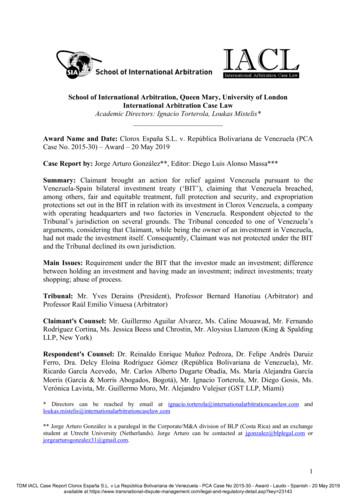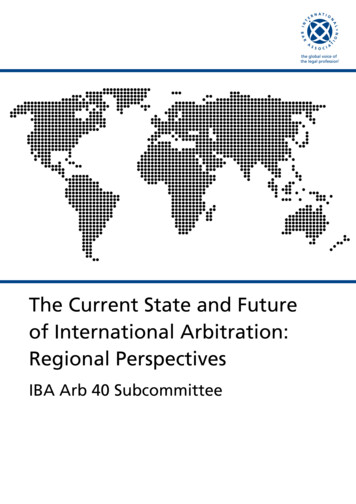
Transcription
The Current State and Futureof International Arbitration:Regional PerspectivesIBA Arb 40 Subcommittee
Table of ContentsPreface 6Chapter 1: Executive Summary 71.1 The background 71.2 Rise in arbitration as a dispute resolution mechanism 91.3 Common factors identified as key to growth 91.4 Common factors identified as hurdles to growth 101.5 The role of arbitral institutions in arbitration procedures 111.6 Lack of appetite for an a-national award 111.7 International, regional and emerging seats 171.8 Institutions – key trends 131.9 Specialism in arbitration 151.10 Increasing competition – a hurdle for young arbitration practitioners 151.11 Development of current hot topics 161.12 Advancements in technology 181.13 Predictions for key trends in jurisprudence 18Chapter 2: Africa 202.1 Current state of arbitration in the region 202.2 Increased use of arbitration 202.3 Seats 202.4 Institutions 212.5 Tribunals 212.6 Career development 212.7 Final thoughts on development in the region 22AUGUST 2015 The Current State and Future of International Arbitration: Regional Perspectives 3
Chapter 3: Asia-Pacific 233.1 Current state of arbitration in the region 233.2 The next five years 233.3 Seats 243.4 Institutions 243.5 Tribunals 253.6 Career development 253.7 Final thoughts on development in the region 26Chapter 4: Europe 274.1 Current state of arbitration in the region 274.2 The next five years 274.3 Seats 274.4 Institutions 284.5 Tribunals 284.6 Career development 294.7 Final thoughts on development in the region 29Chapter 5: Latin America 305.1 Current state of arbitration in the region 305.2 Increased use of arbitration 305.3 Seats 305.4 Institutions 315.5 Tribunals 315.6 Career development5.7 Final thoughts on development in the region 4 32The Current State and Future of International Arbitration: Regional Perspectives AUGUST 2015
Chapter 6: Middle East and North Africa 336.1 Current state of arbitration in the region 336.2 Increased use of arbitration 336.3 Seats 336.4 Institutions 346.5 Tribunals 346.6 Career development 346.7 Final thoughts on development in the region 35Chapter 7: North America 367.1 Current state of arbitration in the region 367.2 Increased use of arbitration 367.3 Seats 367.4 Institutions 377.5 Tribunals 377.6 Career development 387.7 Final thoughts on development in the region 38Chapter 8: Methodology 39Chapter 9: Appendices 409.1 Africa 409.2 Asia-Pacific 459.3 Europe 649.4 Latin America 759.5 Middle East and North Africa 839.6 North America 90AUGUST 2015 The Current State and Future of International Arbitration: Regional Perspectives 5
PrefaceCatherine Amirfar, US State Department and Julien Fouret, Betto SeragliniCo-Chairs, IBA Arb40 Subcommittee.The IBA Arb40 Subcommittee was created to meet the IBA Arbitration Committee’s goal of engagingactively with younger members of the arbitration community. Created in 2014, the Subcommittee providesa platform for the younger members of the global arbitration community to meet, exchange ideas andlearn from peers and more experienced practitioners. With the support of the IBA Arbitration CommitteeCo-Chairs, Paul Friedland and Anne-Veronique Schlaepfer, the IBA Arb40 Subcommittee has worked togalvanise its members around issues important to the future of the international arbitration community.We were fortunate to have been appointed as the first two Co-Chairs. We were also fortunate to be ableto recruit a tremendously talented Steering Committee composed of 16 individuals representing the nextgeneration of leaders in the field, drawn from all over the world and from all aspects of internationalarbitration, both public and private practice. This Report illustrates their exceptional commitment to thework of the Subcommittee over the past two years.The present Report is the first publication by the Subcommittee and considers regional perspectiveson the primary issues facing arbitration in the next five years in six regions: Africa, Asia-Pacific, Europe,Latin America, Middle East and North Africa and North America. While not intended to be an empiricalsurvey, this Project provided a singular opportunity for over 160 arbitration practitioners in more than40 countries to voice their ideas, concerns, proposals and perspectives on the evolution of internationalarbitration in their respective regions. We hope you find their insights as useful as they are unexpected.While all the members of the Steering Committee of the Subcommittee should be thanked for their inputin the early phase of this project in suggesting questions and key themes to be developed, special thanksneed to be offered to Angeline Welsh, Allen & Overy. Since the very outset of the project, Angeline hasbeen its mastermind and then its conductor.The team of Steering Committee members in charge of each of the regions described in the Report alsomust be thanked for their efforts to identify individuals in each region and to organise the input for theReport: For Africa: Tunde Ogunseitan, ICC For Asia-Pacific: Swee Yen Koh, WongPartnership, Sue Hyun Kim, Bae, Kim & Lee andJames Morrison, Allens. For Europe: Christopher Harris, 3 Verulam Buildings and Sarah Morton, Shell. For Latin America: André de A. Cavalcanti Abbud, Barbosa Müssnich Aragão and Ignacio MinoriniLima, Bruchou, Fernández Madero & Lombardi. For Middle East and North Africa: Amani Khalifa, Khalifa Associates. For North America: John Siwiec, Perley-Robertson, Hill & McDougall and Patrick Pearsall, US StateDepartment.Finally, we would also like to extend our thanks to those practitioners who gave up their valuable time toparticipate in this project.We look forward to the conversations we hope this Report will spark.6 The Current State and Future of International Arbitration: Regional Perspectives SEPTEMBER 2015
Chapter 1: Executive SummaryBy Angeline Welsh1.1 The backgroundThe IBA Arb 40 Subcommittee set out to discover what difference, if any, a regional perspective wouldmake to practitioners’ assessment of the issues and challenges facing international arbitration, withparticular emphasis on those which may impact the next generation of arbitration practitioners.The Subcommittee surveyed arbitration practitioners from six different regions: Africa; Asia-Pacific;Europe; Latin America; the Middle East and North Africa (MENA) and North America.1 While theresults involve a certain degree of generalisation given the number and diversity of jurisdictionscovered by each region, interesting observations can be made about the development of arbitrationin each region and how this compares between them.All eyes in the arbitration community are on the future, or at least they appear to be. As this reportshows, the future means something different depending on where you are in the world. In Europeand North America, where international arbitration has been prevalent for many years, a number ofwell-respected arbitral seats and institutions developed which dominated the world of internationalarbitration for many years and, arguably, still do. However, the rise of international arbitration inAsia-Pacific means that Asian arbitral seats and institutions are now dominant in Asia-Pacific and areexpected to continue to take market share away from seats and institutions in Europe and NorthAmerica. Will other regions follow Asia-Pacific by seeing the rise of regional arbitral seats and rulesfor international arbitration? On the whole, the practitioners surveyed are not predicting this willhappen in the immediate future. In Africa and Latin America, international arbitration is stilloften conducted outside the region, predominantly in Europe and North America. As a result ofthe differing stages of development across the regions, different regions face different issues andchallenges, which are described in more detail below.Nevertheless, international arbitration is on the rise in all six regions, generating an increasinginterest in the practice of it as well as concerns about some core issues. As the practice ofinternational arbitration begins to develop globally, two broad trends may be observed.First, there is a growing standardisation of international arbitration practice. The biggest indicatorsof this are the convergence of arbitral institutional rules and a greater number of arbitral seats whereparties can expect a modern and pro-arbitration approach from the judiciary.Secondly, as international arbitration practice becomes more standardised, the handling ofinternational arbitration disputes tends to stay within a particular region as certainty and confidencein the arbitration process within that region grows.Practitioners are generally happy with the development of international arbitration within thisstructure. There is little appetite for a truly international framework, with a near universal rejection1The methodology adopted is set out in Chapter 8 of this report. High-level summaries for each of the regions surveyed can be found inChapters 2–7 of this report. More detailed summaries can be found in the Appendices found in Chapter 9.SEPTEMBER 2015 The Current State and Future of International Arbitration: Regional Perspectives 7
of concepts such as an a-national award and a supranational body to oversee the arbitration processand arbitral awards.The bad news for the future generation of arbitration lawyers from regions where arbitration is welldeveloped is that there is expected to be greater competition in the field. But there is better news forthose practising in regions where the practice of international arbitration is still developing and thepool of specialised international arbitration practitioners is much smaller.This introduction seeks to bring together and compare the key issues and challenges identified by thepractitioners surveyed. It features a number of key observations, which are explored in greater detailin the chapters which follow, such as: Arbitration as a dispute resolution mechanism is on the rise in all regions. Common factors exist in all regions which are regarded as key to growth. Common factors exist in all regions which are regarded as hurdles to growth. Arbitral institutions were commonly regarded as playing a key role in effecting change to thearbitration process. As the practice of international arbitration becomes more established in a region, seats within thatregion begin to dominate. But there is no appetite for an a-national award (an award that is notgoverned by any country’s domestic arbitration law). The trend among institutions is towards regionalism and arbitration rules becoming morehomogenous. However, practitioners ruled out the development of a supranational body – tooversee arbitration – as a realistic prospect. Where arbitration practice is developing, greater specialism in arbitration procedure was generallyregarded as a good thing. In more developed regions, views were mixed with some practitionersconsidering more subspecialisation in a type of arbitration to be important, while others werewary of overspecialisation. All participants welcomed specialisation in sector knowledge. Increasing competition was perceived to be the main hurdle for young arbitration practitioners. There are a number of interesting developments in international arbitration, such as:– Interim relief and emergency arbitrators: it remains to be seen whether this will be asignificant development.– Third-party funding: in many jurisdictions this is prohibited or there is legal uncertainty as towhether this is permissible. In those jurisdictions where it is permitted, practitioners predicta rise.– Issue conflict: This is an issue most prevalent in investment treaty arbitration, and may bealleviated by the expansion of the available pool of arbitrators in the future. Advancement in technology will support, not radically change, the arbitration process. Predictions for key trends in terms of jurisprudence focus on investment treaty arbitration andarbitral awards.8 The Current State and Future of International Arbitration: Regional Perspectives SEPTEMBER 2015
1.2 Rise in arbitration as a dispute resolution mechanismAll regions reported a rise in arbitration as a dispute resolution mechanism, even those where it haslong been established such as North America. In Latin America, Africa and certain parts of AsiaPacific, national court litigation is still the most commonly used dispute resolution method, butgrowth in international arbitration is anticipated.1.3 Common factors identified as key to growthFactors which were generally regarded as key to growth include: Legislative reform. Government support was seen as playing an important role in the developmentof arbitration in Asia-Pacific, particularly Hong Kong and Singapore, and more recently Malaysiaand South Korea. Recent changes in legislation in Italy, Belgium and Finland were also seen ascontributing to a rise in arbitrations in those jurisdictions. Practitioners identify the followingjurisdictions where legislative reform could have a significant impact: Qatar, the United ArabEmirates (UAE), India, South Africa, Myanmar, Colombia, Argentina, Brazil, China and Californiain the United States. Party autonomy. The ability of the parties to control the process through appointment ofarbitrators and procedural flexibility. Enforcement regime. The importance of being able to enforce awards under the Convention on theRecognition and Enforcement of Foreign Arbitral Awards (‘the New York Convention’). This wasseen as particularly compelling for users in Asia-Pacific given the diversity of legal systems, levels ofeconomic development and challenges within legal systems and enforcement regions. Time and cost inefficiencies associated with national courts. This is especially a factor in Latin America,MENA, Africa and Asia-Pacific where, with some exceptions, significant concerns were reportedin relation to the national court system. In MENA, political unrest had frustrated the ability ofsome courts to operate effectively. In Europe and North America, the costs and time involvedwith national proceedings are beginning to be regarded as a neutral factor when compared toarbitration, although this is not true for all jurisdictions in Europe (eg, Belgium, Finland andItaly). Expertise. Lack of cross-border dispute and sector expertise in the national court system wasreported as a factor driving parties towards arbitration. Neutrality. International arbitration is regarded as being particularly suited to the rise of crossborder transactions where parties may not be accustomed to the culture and language of thenational courts of their counterparty. This is of particular importance where the national courtsystem does not use English as a foreign language; for example, the courts in Japan and SouthKorea. Confidentiality. This is still regarded as a ‘push factor’ in favour of arbitration, especially in certainsensitive industry sectors such as pharmaceuticals.SEPTEMBER 2015 The Current State and Future of International Arbitration: Regional Perspectives 9
1.4 Common factors identified as hurdles to growthHurdles to future growth identified include: Legislative reform and court support. This was seen as essential to establishing a pro-arbitrationjurisdiction and predictions for legislative reform are coupled with predications that, in future,arbitrations will be referred to seats within the region. Legislative reform is a particular issue forregions where international arbitration is not as prevalent or those where arbitrations still tend tobe seated outside the jurisdiction, such as Latin America, MENA and Africa. Court interventionin the arbitral process was identified as a particular issue in some jurisdictions (eg, Ukraineand Russia). In Africa, it was observed in many jurisdictions that there is often a lack of supportgenerally from the courts, if not hostility on occasions. In MENA, some concerns were expressedabout court support for arbitration and the enforcement of arbitral awards. Increasing costs. This was of particular concern to practitioners in Europe and North America,and was seen as the result of the import of more burdensome processes into arbitration, suchas extensive disclosure and lengthy submissions. However, cautious optimism was also expressedthat this challenge would be met through the use of expedited timetables and cost guidelines. InAfrica and in certain parts of Asia-Pacific, the cost of arbitration was seen as one of the factors thatinhibited its growth, especially where court fees are likely to be lower. Limited pool of arbitrators. This was of particular concern to practitioners in Europe, North Americaand Asia-Pacific. Primarily, the concern expressed was that a limited pool of arbitrators is leadingto delays in the proceedings and awards being rendered. However, other concerns were expressedincluding that arbitrators were not being proactive enough by identifying preliminary issues,were not prepared for hearings, were too biased in favour of the appointing party and were notproducing quality arbitral awards. Concerns relating to enforceability of the award. While the New York Convention in theory imposes abroad geographical pro-arbitration structure for enforcement of awards, concerns were still raisedabout the robustness of national courts in enforcing arbitral awards. For example, in Vietnam,Indonesia, Argentina, Mexico and in many African jurisdictions, practitioners had encountereddifficulties in enforcing awards. Court reform. In Europe and Asia-Pacific in particular, it was noted that arbitration faces increasedcompetition from national courts that have set their sights on re-establishing their pre-eminencein cross-border dispute resolution for example, through developments like the bringing in ofJudges with specialist and international expertise, the making of legislative amendments allowingfor wider jurisdiction to hear cross border disputes, the setting up of commercial courts, the useof foreign language and the simplification of court procedure. Transparency. Some practitioners in Europe expressed the view that calls for transparency may leadto arbitration becoming less confidential.10 The Current State and Future of International Arbitration: Regional Perspectives SEPTEMBER 2015
1.5 The role of arbitral institutions in arbitration proceduresPractitioners in Asia-Pacific, Europe and MENA believe that the arbitral institutions will play a keyrole in driving change in arbitration procedures by monitoring tribunal availability and introducingtime-saving features such as summary judgment and arbitrator declarations of availability.While it was also generally recognised that counsel could do more in terms of putting pressure ontribunals to act more efficiently, it was also accepted that counsel was reluctant to do this for fearof upsetting the tribunal. Some practitioners expressed the view that if requirements for speed andefficiency were codified in arbitral institutional rules, this would give counsel a legitimate basis forpressing for reform in these areas – which reinforces the general view of the role which arbitralinstitutions have to play.Few practitioners identified arbitrators as being the catalyst of change although, as noted below, manypractitioners believed that there should be a greater pool of arbitrators. This might, in turn, lead to achange in arbitral practice.1.6 Lack of appetite for an a-national awardAs the practice of international arbitration becomes more established as a dispute resolution option,seats within that region begin to dominate. As arbitration has taken hold in Asia, the seats of Hong Kong and Singapore have become wellestablished, with the consequence that disputes within Asia-Pacific are predominantly referred toarbitrations seated in Asia rather than Europe or the US. This trend is expected to increase andmay take in new Asian seats such as Malaysia. There are a number of well-established and respected seats in Europe and North America. Paris,London, Geneva, Zurich, Stockholm, New York, Washington DC, Miami, Houston, Toronto andVancouver appear to dominate. Perhaps of greater interest is the awareness of European and USpractitioners of seats outside these regions, particularly the Asian seats. This tends to suggest thata greater proportion of disputes from the Europe and North America regions are being referredto Asian-seated arbitration. Latin America and Africa still often look towards more established seats in Europe and the US.Predictions on the rise of ‘safe’ seats in these jurisdictions are cautious, and will depend on asignificant leap forward in terms of legislative reform. MENA has the well-established seat of Dubai but still looks to London, Paris and Geneva.Generally speaking, it is optimistic about reform in other jurisdictions within the region,notwithstanding recent political instability in some places. In Africa, parties still look to London, Paris and Geneva, with Mauritius as a potential upcomingalternative. However, Johannesburg, Kigali and Lagos are all expected to become rival seats forinternational arbitration within the next five to ten years.Practitioners in all regions reject the idea of an a-national award with no seat. A major objectionwas one of practicality; it would require amendments to the New York Convention to be agreed bySEPTEMBER 2015 The Current State and Future of International Arbitration: Regional Perspectives 11
the contracting states and a transnational lex arbitri. This was seen as difficult, if not impossible, toachieve. In any event, the majority of practitioners did not consider a-national awards to be desirable.In particular, it was considered that parties benefit from having the stability provided by state controlover arbitration proceedings. Having a seat as a point of reference creates certainty, as parties knowwhere they need to go to get interim relief and to review or to challenge an award.1.7 International, regional and emerging seatsMap of international, regional and emerging seats according to those surveyedAfrica Safe seats for international arbitration were regarded as London, Paris and Geneva, withMauritius as an upcoming alternative. Seats within the region (eg, Johannesburg, Kigali and Lagos) are expected to be rivals as seatsfor international arbitration within the next five to ten years.Asia-Pacific Singapore and Hong Kong are regarded as the safest seats in the region. Singapore appearsto be emerging as the preferred seat for Southeast Asia and India-related disputes, and HongKong for China-related disputes.12 The Current State and Future of International Arbitration: Regional Perspectives SEPTEMBER 2015
London and Paris are also regarded as safe seats but the trend is for disputes to shift away fromthese centres to Singapore and Hong Kong. Regionally established seats include Delhi and Sydney. Seats to watch for include Kuala Lumpur and Seoul.Europe Paris, London, Geneva and Zurich were still the most prevalent. Stockholm was alsomentioned for the Nordic countries and disputes related to Russia and China. Vienna, Helsinki, The Hague and Frankfurt were also mentioned, and Madrid in relation toLatin America- and Spain-related disputes.Latin America Practitioners still often look to established seats outside the region, such as Paris and NewYork. There is an array of emerging seats in the region (São Paulo, Rio de Janeiro, MexicoCity, Montevideo, Santiago de Chile and Bogotá), with no clear frontrunner.Middle East Paris, London and Geneva are still regarded as the predominant seats. Seats to watch out for include Dubai, Cairo, Tunis, Beirut and Riyadh. The DubaiInternational Financial Centre (DIFC) was regarded as an up-and-coming seat.North America In Canada, Toronto was regarded as an internationally established seat. For regional disputes,Vancouver, Calgary, Montreal and Ottawa were named. Internationally established US seats include New York and Washington DC. Miami, Chicagoand Houston were regionally named seats. It is expected that California may become apopular seat in the future if there is legislative reform.1.8 Institutions – key trendsRegionalismDifferent regions have a preference for different rules, although the International Chamber ofCommerce (ICC) appears to have a presence in all regions.Practitioners in all regions report widespread use of the ICC Rules of Arbitration.In Europe, North America and Asia-Pacific, other institutions are also well established and widelyused. For Europe these are the London Court of International Arbitration (LCIA), the InternationalCentre for Dispute Resolution (ICDR) of the American Arbitration Association (AAA), the SwissSEPTEMBER 2015 The Current State and Future of International Arbitration: Regional Perspectives 13
Arbitration Association (ASA), the Vienna International Arbitral Centre (VIAC) and the ArbitrationInstitute of the Stockholm Chamber of Commerce (SCC). For North America these are the LCIAand the ICDR. For Asia-Pacific, the Singapore International Arbitration Centre (SIAC) and the HongKong International Arbitration Centre (HKIAC) are now well established, something which drewcomment from not only practitioners within that region but also in North America and Europe. AsiaPacific practitioners predict that users will continue to favour arbitration within the region ratherthan Paris and London.In China, Africa and MENA, national arbitral institutions are still the most commonly used, aboveother arbitral institutions which might be considered more global in their reach, such as the ICC andthe LCIA. This appears to be, in part, a reflection of a greater number of domestic arbitrations inthese regions.In MENA, in particular, practitioners expressed a preference for the LCIA or the ICC for high-valuecases, and specialist institutions for certain sectors such as the Court of Arbitration for Sport or theLondon Maritime Arbitrators Association (LMAA).In Latin America, the ICC is the dominant arbitral institution, alongside other national institutions,but the latter is more likely to handle domestic arbitration.Overall, some practitioners predict a growth in regional arbitral institutions, while others thoughtthat it was not likely that the less-established arbitral institutions would gain in market share over themore established institutions.Arbitration rules are becoming more homogenousMany of the practitioners surveyed agreed that institutional rules were becoming more homogenous.Overall this was seen as a good thing; a reflection of international best practice and a willingness tomeet the demands of users through, for example, expedited procedure. It was also observed thatthe homogenisation of institutional rules is likely to support the trend towards regionalisation, asthis increases the likelihood that a counterparty will accept an institution in a different jurisdiction.However, there remained a sense that arbitral institutions could still be differentiated on the basisof culture, cost structure and certain unique features, such as the different variations of joinder/consolidation provisions and scrutiny of the award.Development of a supranational body to oversee arbitration is an unrealistic prospectWe asked those surveyed whether there was any appetite for a supranational body to overseeinternational arbitration to address uniformity, predictability and ethical conduct in the field. Thenear consensus, across all regions, was that this was not a real possibility in the near future. Primarily,this was due to a lack of political will and consensus.Those in favour of a supranational body cited the following advantages: the removal of unsupportivecourt intervention; uniformity over annulment proceedings; and regulation of ethical issues andquality.14 The Current State and Future of International Arbitration: Regional Perspectives SEPTEMBER 2015
Those against, or sceptical of, a supranational body thought that it would be impractical, unwieldyand bureaucratic. Many also questioned whether uniformity is desired or needed.1.9 Specialism in arbitrationWhere arbitration practice is developing, greater specialism in arbitration procedure was generallyregarded as a good thing. In more developed regions, views were mixed, with some practitionersconsidering greater subspecialisation in a type of arbitration as important, and others wary ofoverspecialisation. All welcomed specialisation in sector knowledge.In Africa and MENA, practitioners reported a general need for greater specialism in arbitrationprocedure. Practitioners in both regions observed that the lack of specialism in the area contributedtowards a limited pool of arbitrators, which had a knock-on effect on the efficiency of the processin their jurisdictions. In Latin America, many practitioners also reported an increasing demandfor lawyers who are specialised in international arbitration, although some were also wary ofoverspecialisation.In Asia-Pacific, specialisation in arbitration procedure was regarded on the whole as a good thing– up to a point. There are a number of jurisdictions within the region where it was felt that greaterspecialism is required (eg, Myanmar, Indonesia, the Philippines and Thailand). Greater specialismwas regarded as a positive development in order to avoid the import of national court procedureswhich might result in inefficiencies. However, practitioners also observed that it should not becomeso specialised that arbitration became inaccessible to non-specialists.In North America, the consensus was that practitioners were not specialised enough, and increasingspecialism would enhance the quality of practitioners and resulting awards generally. However, likeAsia-Pacific, there were concerns that an overspecialised group of practitioners would make it lessaccessible to other practitioners and that this, in turn, would give rise to potential legitimacy issues.Con
Table of Contents Preface 6 Chapter 1: Executive Summary 7 1.1 The background 7 1.2 Rise in arbitration as a dispute resolution mechanism 9 1.3 Common factors identified as key to growth 9 1.4 Common factors identified as hurdles to growth 10 1.5 The role of arbitral institutions in arbitration procedures 11 1.6 Lack of appetite for an a-national award 11 1.7 International, regional and .
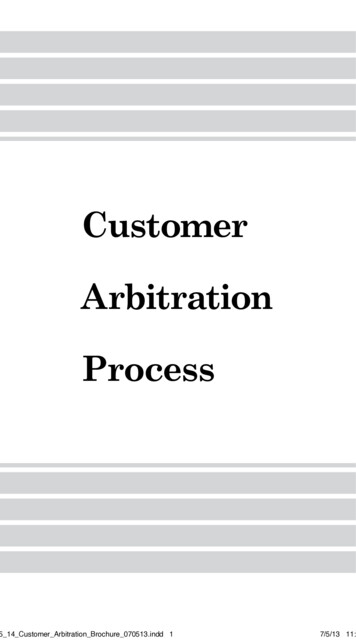
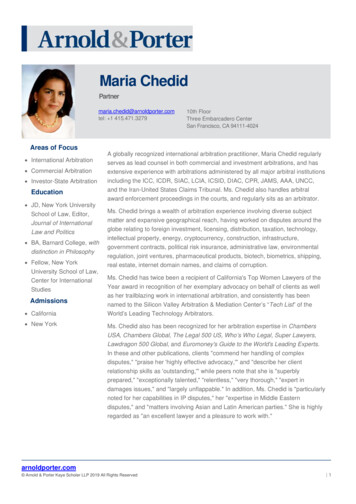


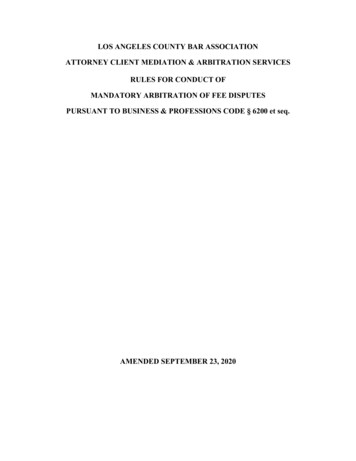
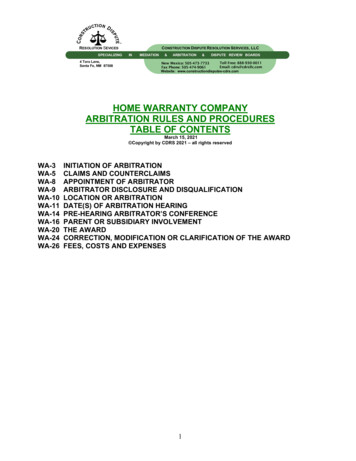
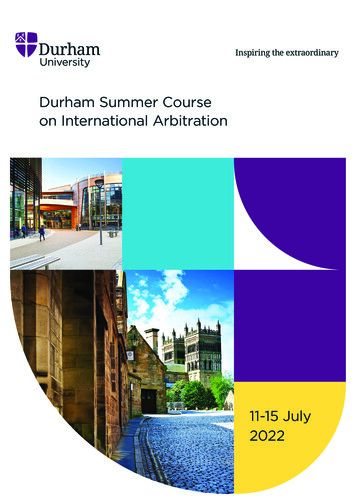

![NIAS EN COLOMBIA - Normas de Aseguramiento [Modo de compatibilidad]](/img/18/nias-en-colombia-normas-de-aseguramiento.jpg)
